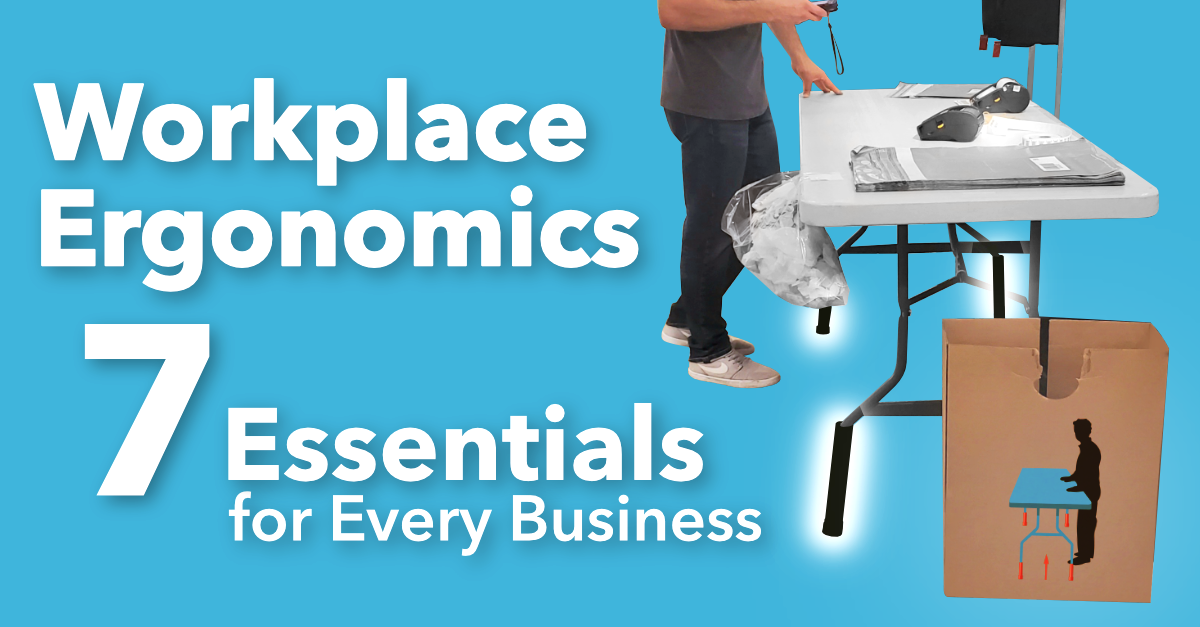What is Ergonomics in the Workplace?
Ergonomics has been a popular workplace buzzword in recent years, but what does it actually mean?
Ergonomics is the science of designing products and systems for people to improve efficiency and productivity while preventing harm. Innovations in ergonomics have profoundly affected how we create products and processes for employees in every industry. From the desk you use to how workers operate on the factory floor, every step of the process has been guided and improved by ergonomics.
While the ergonomics industry has been around for decades, the innovative solutions entering the marketplace are only scratching the surface of their ability to reduce costs, increase productivity, and improve the health of workers.
So how should your business handle ergonomics?
The Types of Ergonomics
Ergonomic products and solutions focus on improving three key aspects of work: physical, cognitive, and environmental.
Physical Ergonomics
This refers to the physical toll placed on the body when completing a task. This can include the physical effort of carrying heavy objects, performing repetitive tasks, or even staring at a computer screen for hours on end.
When most people think of ergonomics, they consider physical ergonomics. Some popular solutions include ergonomic chairs, folding table risers, anti-fatigue mats, and ergonomics job training to improve physical tasks.
Cognitive Ergonomics
Cognitive ergonomics refers to the mental processes it takes to complete tasks, such as decision-making, memory, perception, and reasoning. Creating ergonomic solutions to alleviate cognitive stress focuses on optimizing workplace processes. This can include investments in communication and administrative software, reorganizing teams and business groups, communications training, and more.
Environmental Ergonomics
Environmental ergonomics refers to the way in which workers react in a specific environment. This considers factors such as noise, temperature, light, and other things that can create a disruptive environment. Some environmental ergonomics solutions include investments in air-conditioning, tinted windows, non-fluorescent lighting, and ear protection.
1. Ergonomics Can Reduce Costs
Every year, American companies lose billions of dollars from the true costs of workplace injuries and losses in productivity. In 2020 alone, US companies lost $163.9 billion from injuries that could’ve easily been prevented.
One of the most common and most preventable workplace injuries are musculoskeletal disorders (MSDs). These include injuries like carpal tunnel, tendinitis, rotator cuff injuries, trigger fingers, muscle strains, lower back injuries, and more. With about $1 out of every $3 in workers’ compensation claims attributed to MSDs, preventing these instances represents huge cost savings opportunities.
Fortunately, most MSDs are preventable. By implementing ergonomic products and processes, companies can significantly reduce the number of worker’s compensation claims. Investments in ergonomics can translate into:
- 75% reduction in lost workdays
- 68% reduction in worker’s compensation costs
- 65% average reduction in the incidence rate
- 59% reduction in MSDs
- 43% decrease in labor costs
- 39% decrease in cost per claim
2. Ergonomics Improves Workers’ Health
Employees at ergonomic workstations experience improved physical health, beginning with the cardiovascular system and extending to other areas. Working in an ergonomic setup helps to keep your heart healthier than it would be in a standard work environment. It also helps to minimize work-related injuries caused by over-exertion or strains.
Ergonomics also has significant benefits for mental health as well. These benefits can help to elevate mental clarity, promote better concentration, and increase blood flow. When you are comfortable and feeling at ease, you can be more focused, and your mental insight is likely to improve. By taking the time to focus on ergonomics, you can be more successful in your work.
3. Ergonomics Improves Productivity
While ergonomics are built for comfort and to prevent workplace injuries, they result in improvements in productivity. By designing workplace processes to allow for less exertion, good posture, fewer motions, and better heights and reaches, employees can work faster with less effort.
4. Ergonomics Improves Quality
Poor ergonomics can lead to disgruntled and fatigued workers that can’t perform their tasks to the best of their ability. When workplace tasks become too physically, mentally, or emotionally demanding, the results can be seen in the products or services they produce. By investing in ergonomics products and solutions, companies can improve workplace conditions for their employees.
5. Ergonomics Improves Employee Engagement
When the company puts in the effort to guarantee the health and safety of its employees, the employees take notice. If employees don’t feel exhausted and uncomfortable during the workday, it can lead to a lower turnover rate, fewer absences, a better attitude, and more involvement from the staff.
6. Ergonomics Creates a Safety Culture
Demonstrating your company’s commitment to safety and health through ergonomics can have an immensely positive impact. This provides a cumulative effect of the benefits of ergonomics, resulting in a more robust safety culture. Your employees are your most prized resource, and by cultivating and nurturing the safety and health environment at your firm, you can ensure that they are able to perform optimally and effectively.
7. Ergonomics Removes Workplace Hazards
In order to create a more productive work environment, it is important to identify and eliminate any hazards that may be present. This might be as simple as customizing the workplace to suit the user. This can be achieved by cutting down on distractions, properly illuminating and ventilating the space, as well as providing and/or adapting furniture and equipment to create a working environment that is appropriate for the job. A productive way to engage your staff is to ask for their opinion on what hazards they spot in the environment, or things they think should be improved to make their workstation safer. This also shows your staff that you value their opinion which can lead to improved employee engagement when their ideas are considered and implemented.
Next Steps: Implementing Workplace Ergonomic Solutions
Understanding the importance of ergonomics is a great first step to creating a safer, more productive workplace. Now that you’re armed with this information, it’s time to implement these changes.
Step 1: Managerial Initiative
For the successful implementation of ergonomic practices in the workplace, it is necessary to take a top-down approach. Managers and organizational leaders should lead the way by investing time and money in creating an environment that values safety and ergonomics.
This will demonstrate to staff that their safety is a priority and show commitment to the process. Further, managers should define goals, set a budget for implementation, hold meetings with staff, assign responsibilities, and communicate openly and clearly.
Step 2: Employee Involvement
It is the responsibility of managers to take the lead in creating a safe work environment. However, it is vital that employees from all levels contribute to the cause in order to make an impact. Assessing the workplace, creating solutions, and executing practices that promote worker safety need to be done with employee feedback.
Because employees are the ones who use the equipment, machines, and furniture on a daily basis, they can provide valuable insight into any potential hazards. Consequently, employee involvement is essential for providing feedback and assessing the ergonomic process.
Step 3: Identify Safety Issues
An integral part of introducing ergonomic practices is assessing the offices, factories, warehouses, and any other workspaces in order to identify any potential problems before they cause harm to employees. Examining records of injury and illness, such as workers’ compensation reports, first aid records, accident investigations, and insurance company records, can help with this step. Additionally, observing the workplace for injury risk factors such as repetitive motions, uncomfortable postures, exertion of excessive force, vibrations, and extreme temperatures can be beneficial in making necessary ergonomic alterations.
Step 4: Frequent Reporting
Organizational and managerial leaders should urge their workers to report any injuries or symptoms they experience in the workplace as soon as possible in order to identify any potential problems, stay apprised of emerging issues, and track progress. This is a critical step in enhancing workplace conditions. If employees stay silent about their injuries, they will only worsen, opening the door for more injuries. However, if they are motivated to communicate with management about any issues they have, they have a better chance of improving their well-being.
Step 5: Mediate Workplace Hazards
Once potential risks and hazards have been recognized and assessed, it is important to implement practical ergonomic solutions to ensure that hazards are controlled. Alterations can be made to the job environment to facilitate more comfortable, ergonomic postures. Let’s take for example the common folding table which is often used by employees who are working in a standing capacity. However, people who work while standing at a folding table are subject to back pain and neck strain simply because their table is positioned too low. With the quick addition of folding table risers, workers can set their workstations to the proper height and prevent fatigue, injury, and loss of productivity.
Companies can also implement procedures that limit repetitive and strenuous activities, such as mandatory rest periods, job rotation, or two people lifting heavy objects. In summary, safety managers should consider using products like folding table risers, ergonomic office chairs, anti-fatigue mats, comfortable shoes, and other practical solutions.
Step 6: Provide Ergonomics Training
Employee training is a crucial part of the process when introducing ergonomic solutions in the workplace. It is important that personnel understand the fundamentals of ergonomics, any matters related to ergonomics at the workplace, the advantages of recognizing potential issues, promptly reporting any symptoms, and the correct use of new tools and equipment. Numerous training materials are available from the Occupational Safety and Health Administration (OSHA).
Step 7: Ergonomic Evaluations
Maintaining an ergonomic environment is an ongoing process. Procedures and policies should be evaluated periodically for their effectiveness and whether improvements or upgrades should be made. Most changes are inexpensive and require little time or money to implement. By regularly assessing your workplace, you can ensure your investments are paying off, and your workers are satisfied.
No scheduled articles yet
When you schedule an article, it automatically posts at the date and time you choose.
Creating a Better Workplace
Ergonomics can be a powerful cost-saving strategy regardless of your company’s size or industry. Ergonomic products and solutions can reduce costs, increase productivity, and improve employee satisfaction.
If you’re looking to improve the ergonomics of your workplace, check out our website to learn more about how our folding table risers can help your organization.
With our flagship folding table risers, you can…




